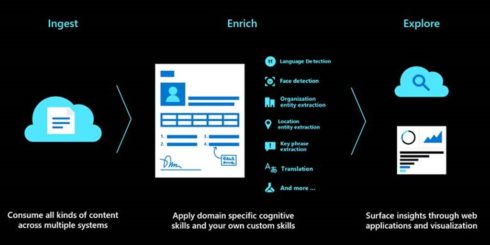
Microsoft Azure Search will now be known as Azure Cognitive Search to signify the next wave of artificial intelligence in the enterprise.
According to Microsoft, the first wave of AI was built for narrow apps, or training a single mode for a specific task. “What’s been challenging, however, is that these models individually can’t capture all the different attributes hidden in various types of content. This means developers must painfully stitch together disparate components to fully understand their content,” John Chirapurath, general manager for Azure Data and AI, wrote in a post.
RELATED CONTENT:
Microsoft launches Project Cortex to help organizations make sense of their data
Is DataOps the next big thing?
A recent report from Harvard Business Review Analytics Services also found 82% of organizations struggle with exploring and understanding content in a timely manner. This is because content is spread over multiple systems and in multiple formats, the report explained.
The next wave of AI will not only span vision, speech and language, but it will be able to unlock insights from all content types such as PDFs, spreadsheets, images and audio files. This next wave will be known as knowledge mining, Chirapurath explained, where AI will move from finding to understanding.
Microsoft’s Azure Cognitive Search solution will offer knowledge mining capabilities that enable enterprises and developers to:
- “Ingest: scale to ingest a multitude of data types
- Enrich: apply artificial intelligence to transform structure and enhance data
- Explore: have the flexibility to build a range of application experiences”
The company is also adding new skills to the solution such as custom entity lookup to find user-defined entities in a given text; and power skills, which are a collection of useful functions.
Other features include code-free skillset management, re-indexing, a custom web app builder, and project multimedia in the knowledge store.
“For decades, the term ‘search’ has been ubiquitous with exploring, finding, and making sense of the information at your disposal. It started with keyword search, allowing users to find specific information that matched a certain keyword or phrase. Then, it evolved into more effective solutions powered by advances in natural language processing and machine learning technologies. Features like fuzzy search, spellers, autosuggest, etc. significantly improved the quality and relevance of search results,” Lance Olson, director of program management at Microsoft, wrote in a post. “Now, there is cognitive search, which broadens the mediums users can explore effectively (PDFs, spreadsheets, images, audio files, etc.), and moves from ‘finding’ to ‘understanding.’ This is made possible by a combination of natural language processing, computer vision, and new advances in machine learning technology.”





